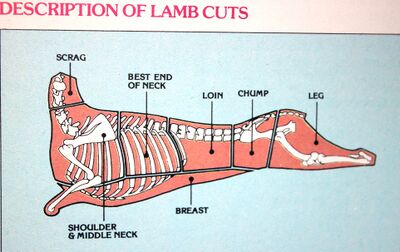Lamb - suitable cooking methods: Difference between revisions
From Cookipedia
m (Increase image size for clarity) |
|||
| Line 9: | Line 9: | ||
}} | }} | ||
<!-- /seo --> | <!-- /seo --> | ||
[[Image:{{PAGENAME}}.jpg|400px|thumb|right|Lamb cuts]] | |||
[[Image:{{PAGENAME}}.jpg| | |||
===Cooking methods by cut=== | ===Cooking methods by cut=== | ||
| Line 17: | Line 15: | ||
* '''Scrag End and Middle Neck''' - usually sold as '''chops''', on the bone and used for [[stewing]] or [[braising]]. They are the traditional cuts for [[Irish stew]] and [[Lancashire hotpot]]. | * '''Scrag End and Middle Neck''' - usually sold as '''chops''', on the bone and used for [[stewing]] or [[braising]]. They are the traditional cuts for [[Irish stew]] and [[Lancashire hotpot]]. | ||
* '''Shoulder''' - A succulent, tender [[roasting]] joint, whether on the bone, or boned, stuffed and rolled. Sold whole, or halved into | * '''Shoulder''' - A succulent, tender [[roasting]] joint, whether on the bone, or boned, stuffed and rolled. Sold whole, or halved into '''blade''' and '''knuckle''', both of which are ideal for [[roasting]] or [[braising]]. | ||
* '''Best End of Neck''' - Can be bought as [[roasting]] joint with a row of 6 or 7 rib bones. The butcher will 'chine' the back bone, for easier carving. It can be [[roasted]] on the bone, or boned, stuffed and rolled. It is often sold as '''cutlets''' with one rib bone to each, for [[grilling]] or [[frying]]. Two '''best end necks''' joined together and curved, bones outwards, is called a '''Crown Roast'''. Facing each other, fat side outwards, they are called a '''Guard of Honour'''. Both of these special occasion dishes can be stuffed before [[roasting]]. This cut is recognisable by the dot of lean beneath the main 'eye' of lean. | * '''Best End of Neck''' - Can be bought as [[roasting]] joint with a row of 6 or 7 rib bones. The butcher will 'chine' the back bone, for easier carving. It can be [[roasted]] on the bone, or boned, stuffed and rolled. It is often sold as '''cutlets''' with one rib bone to each, for [[grilling]] or [[frying]]. Two '''best end necks''' joined together and curved, bones outwards, is called a '''Crown Roast'''. Facing each other, fat side outwards, they are called a '''Guard of Honour'''. Both of these special occasion dishes can be stuffed before [[roasting]]. This cut is recognisable by the dot of lean beneath the main 'eye' of lean. | ||
* '''Loin''' - Either [[roast]] as a piece, or boned, stuffed and rolled. It is usually divided into '''loin end''' and '''chump end''', and cut into '''chops''' for [[grilling]] or [[frying]]. '''Chump chops''' are recognisable by the small round bone in the centre. | * '''Loin''' - Either [[roast]] as a piece, or boned, stuffed and rolled. It is usually divided into '''loin end''' and '''chump end''', and cut into '''chops''' for [[grilling]] or [[frying]]. '''Chump chops''' are recognisable by the small round bone in the centre. | ||
Revision as of 23:25, 19 August 2016

Cooking methods by cut
When buying lamb, the fat should be crisp and white and the lean fine-grained, firm and pinky-brown. There is usually very little gristle. Freshly cut surfaces should look slightly moist and the bones a pinkish-blue. Common cooking methods are as follows:
- Scrag End and Middle Neck - usually sold as chops, on the bone and used for stewing or braising. They are the traditional cuts for Irish stew and Lancashire hotpot.
- Shoulder - A succulent, tender roasting joint, whether on the bone, or boned, stuffed and rolled. Sold whole, or halved into blade and knuckle, both of which are ideal for roasting or braising.
- Best End of Neck - Can be bought as roasting joint with a row of 6 or 7 rib bones. The butcher will 'chine' the back bone, for easier carving. It can be roasted on the bone, or boned, stuffed and rolled. It is often sold as cutlets with one rib bone to each, for grilling or frying. Two best end necks joined together and curved, bones outwards, is called a Crown Roast. Facing each other, fat side outwards, they are called a Guard of Honour. Both of these special occasion dishes can be stuffed before roasting. This cut is recognisable by the dot of lean beneath the main 'eye' of lean.
- Loin - Either roast as a piece, or boned, stuffed and rolled. It is usually divided into loin end and chump end, and cut into chops for grilling or frying. Chump chops are recognisable by the small round bone in the centre.
- Saddle of Lamb - A large roasting joint for a special occasion, which is the whole loin from both sides of the animal, left in one piece.
- Leg - A roasting joint on the bone, or boned, stuffed and rolled. It is often divided into fillet end and shank end.
- Breast - Long, thin cuts, streaked with fat and lean. When boned, rolled and stuffed, it is the most economical cut for roasting or braising